Creighton's Chocolaterie: Analysis of Singapore Expansion (IBP Report)
VerifiedAdded on 2022/08/15
|15
|3067
|22
Report
AI Summary
This report analyzes the international business expansion of Creighton's Chocolaterie, a UK-based chocolate company, into Singapore. The report examines key global trends affecting the chocolate industry, including supply costs, regulatory issues, demand pressures, technological changes, and competitive pressures. It also delves into the Singaporean market, analyzing demand, competition, costs, import regulations, cultural factors, environmental challenges, ethical concerns, and political factors. The report provides recommendations for Creighton's Chocolaterie to successfully enter and thrive in the Singaporean market, focusing on market analysis, competitive landscape, and strategic recommendations for expansion and growth. The report also explores the impact of the ASEAN involvement in the cocoa industry's value chain on the financial growth of the region and suggests that Creighton’s Chocolaterie should focus on the democratization of chocolate and acquire station locations to regional market leaders in Singapore.

Running head: INTERNATIONAL BUSINESS PRACTICE (IBP)
INTERNATIONAL BUSINESS PRACTICE (IBP)
Name of the Student:
Name of the University:
Author note:
INTERNATIONAL BUSINESS PRACTICE (IBP)
Name of the Student:
Name of the University:
Author note:
Paraphrase This Document
Need a fresh take? Get an instant paraphrase of this document with our AI Paraphraser
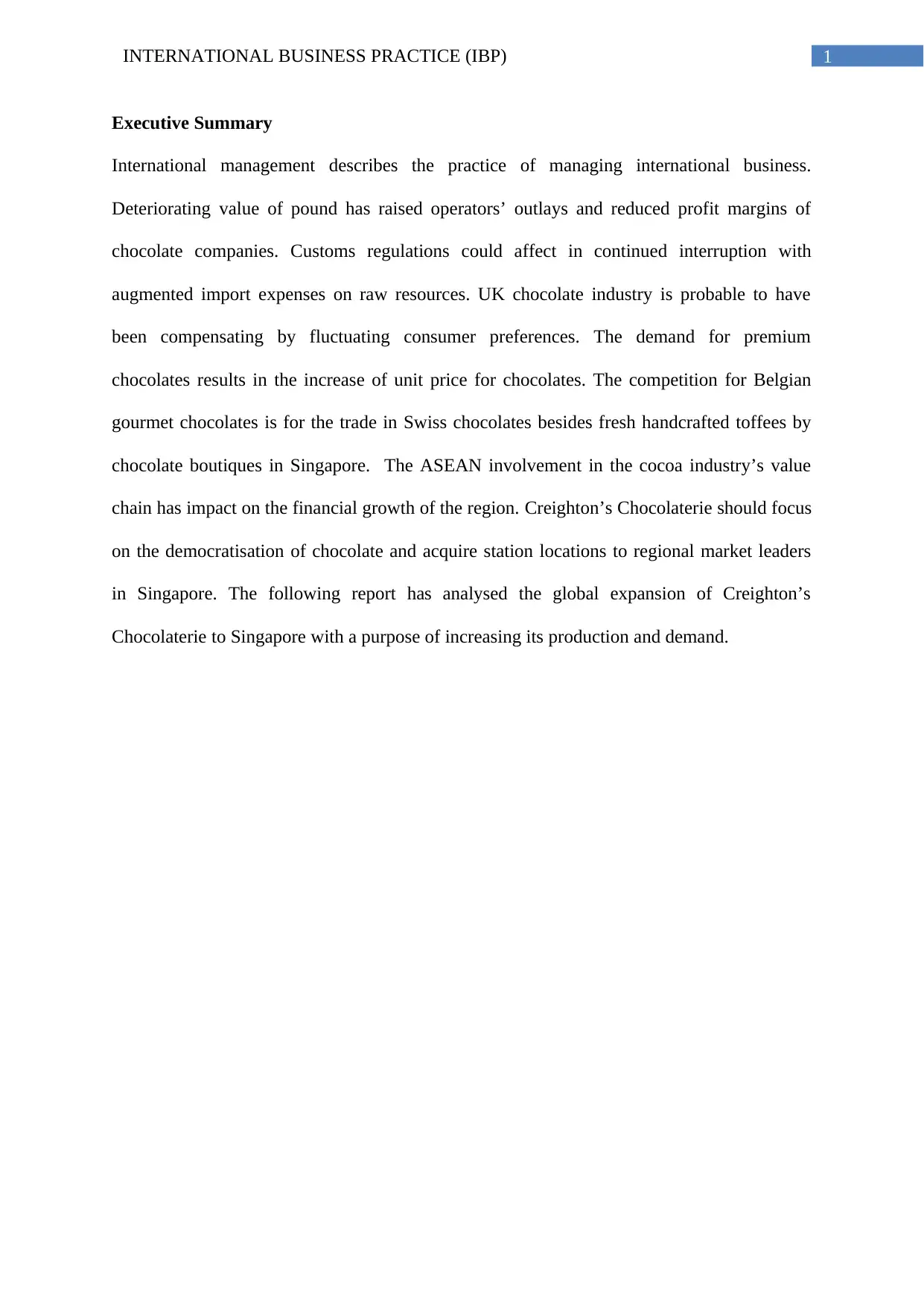
1INTERNATIONAL BUSINESS PRACTICE (IBP)
Executive Summary
International management describes the practice of managing international business.
Deteriorating value of pound has raised operators’ outlays and reduced profit margins of
chocolate companies. Customs regulations could affect in continued interruption with
augmented import expenses on raw resources. UK chocolate industry is probable to have
been compensating by fluctuating consumer preferences. The demand for premium
chocolates results in the increase of unit price for chocolates. The competition for Belgian
gourmet chocolates is for the trade in Swiss chocolates besides fresh handcrafted toffees by
chocolate boutiques in Singapore. The ASEAN involvement in the cocoa industry’s value
chain has impact on the financial growth of the region. Creighton’s Chocolaterie should focus
on the democratisation of chocolate and acquire station locations to regional market leaders
in Singapore. The following report has analysed the global expansion of Creighton’s
Chocolaterie to Singapore with a purpose of increasing its production and demand.
Executive Summary
International management describes the practice of managing international business.
Deteriorating value of pound has raised operators’ outlays and reduced profit margins of
chocolate companies. Customs regulations could affect in continued interruption with
augmented import expenses on raw resources. UK chocolate industry is probable to have
been compensating by fluctuating consumer preferences. The demand for premium
chocolates results in the increase of unit price for chocolates. The competition for Belgian
gourmet chocolates is for the trade in Swiss chocolates besides fresh handcrafted toffees by
chocolate boutiques in Singapore. The ASEAN involvement in the cocoa industry’s value
chain has impact on the financial growth of the region. Creighton’s Chocolaterie should focus
on the democratisation of chocolate and acquire station locations to regional market leaders
in Singapore. The following report has analysed the global expansion of Creighton’s
Chocolaterie to Singapore with a purpose of increasing its production and demand.
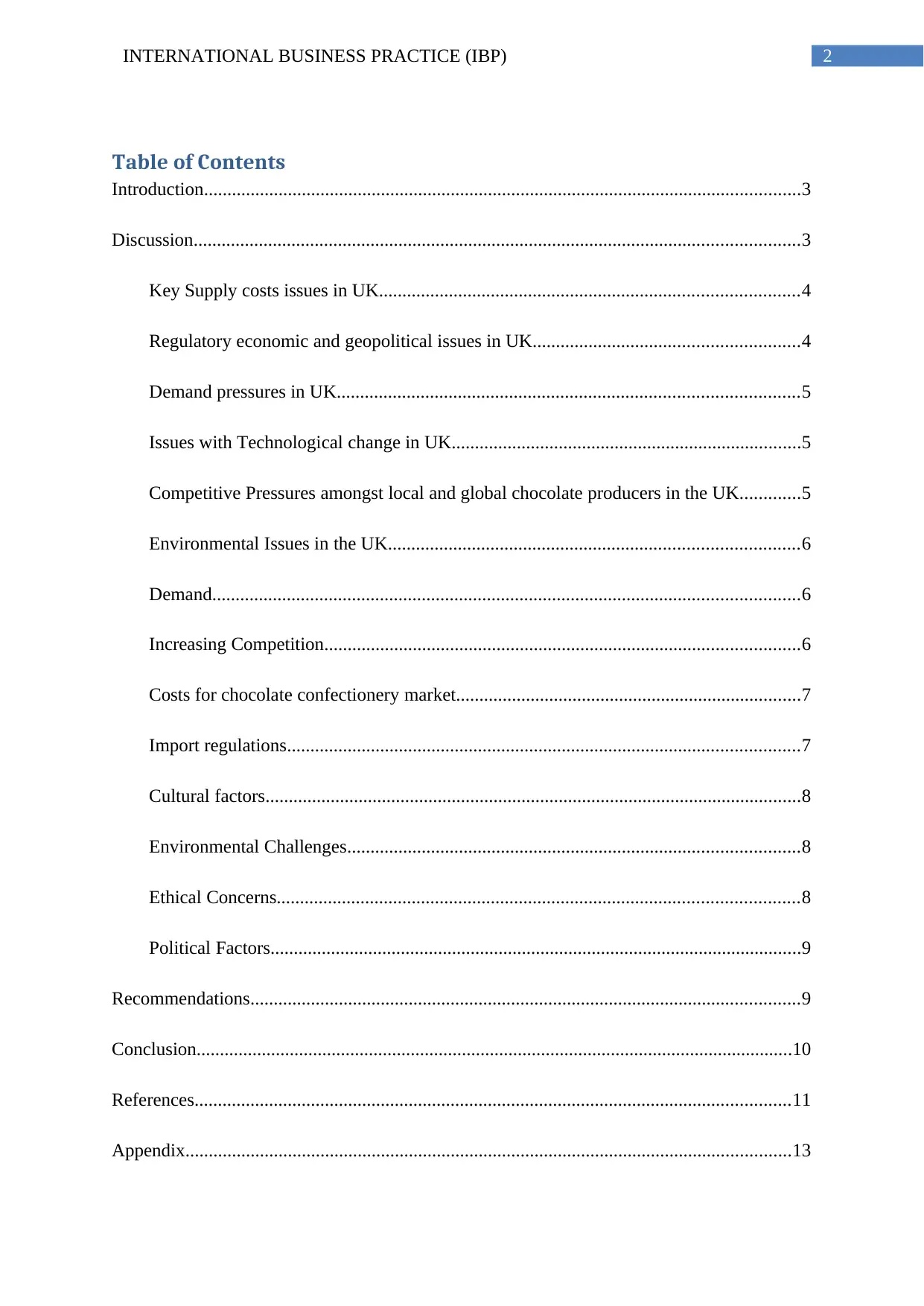
2INTERNATIONAL BUSINESS PRACTICE (IBP)
Table of Contents
Introduction................................................................................................................................3
Discussion..................................................................................................................................3
Key Supply costs issues in UK..........................................................................................4
Regulatory economic and geopolitical issues in UK.........................................................4
Demand pressures in UK...................................................................................................5
Issues with Technological change in UK...........................................................................5
Competitive Pressures amongst local and global chocolate producers in the UK.............5
Environmental Issues in the UK........................................................................................6
Demand..............................................................................................................................6
Increasing Competition......................................................................................................6
Costs for chocolate confectionery market..........................................................................7
Import regulations..............................................................................................................7
Cultural factors...................................................................................................................8
Environmental Challenges.................................................................................................8
Ethical Concerns................................................................................................................8
Political Factors..................................................................................................................9
Recommendations......................................................................................................................9
Conclusion................................................................................................................................10
References................................................................................................................................11
Appendix..................................................................................................................................13
Table of Contents
Introduction................................................................................................................................3
Discussion..................................................................................................................................3
Key Supply costs issues in UK..........................................................................................4
Regulatory economic and geopolitical issues in UK.........................................................4
Demand pressures in UK...................................................................................................5
Issues with Technological change in UK...........................................................................5
Competitive Pressures amongst local and global chocolate producers in the UK.............5
Environmental Issues in the UK........................................................................................6
Demand..............................................................................................................................6
Increasing Competition......................................................................................................6
Costs for chocolate confectionery market..........................................................................7
Import regulations..............................................................................................................7
Cultural factors...................................................................................................................8
Environmental Challenges.................................................................................................8
Ethical Concerns................................................................................................................8
Political Factors..................................................................................................................9
Recommendations......................................................................................................................9
Conclusion................................................................................................................................10
References................................................................................................................................11
Appendix..................................................................................................................................13
⊘ This is a preview!⊘
Do you want full access?
Subscribe today to unlock all pages.

Trusted by 1+ million students worldwide
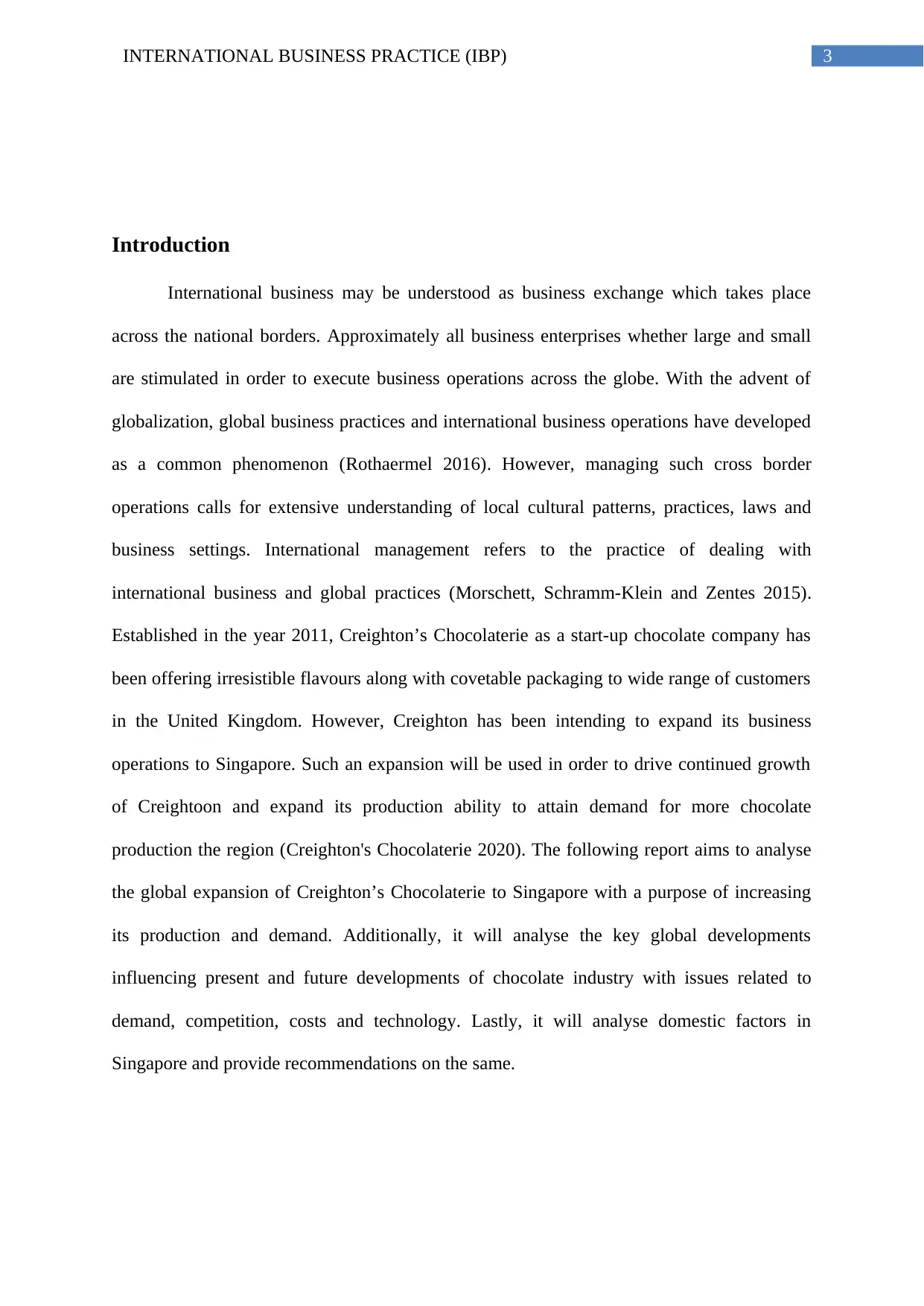
3INTERNATIONAL BUSINESS PRACTICE (IBP)
Introduction
International business may be understood as business exchange which takes place
across the national borders. Approximately all business enterprises whether large and small
are stimulated in order to execute business operations across the globe. With the advent of
globalization, global business practices and international business operations have developed
as a common phenomenon (Rothaermel 2016). However, managing such cross border
operations calls for extensive understanding of local cultural patterns, practices, laws and
business settings. International management refers to the practice of dealing with
international business and global practices (Morschett, Schramm-Klein and Zentes 2015).
Established in the year 2011, Creighton’s Chocolaterie as a start-up chocolate company has
been offering irresistible flavours along with covetable packaging to wide range of customers
in the United Kingdom. However, Creighton has been intending to expand its business
operations to Singapore. Such an expansion will be used in order to drive continued growth
of Creightoon and expand its production ability to attain demand for more chocolate
production the region (Creighton's Chocolaterie 2020). The following report aims to analyse
the global expansion of Creighton’s Chocolaterie to Singapore with a purpose of increasing
its production and demand. Additionally, it will analyse the key global developments
influencing present and future developments of chocolate industry with issues related to
demand, competition, costs and technology. Lastly, it will analyse domestic factors in
Singapore and provide recommendations on the same.
Introduction
International business may be understood as business exchange which takes place
across the national borders. Approximately all business enterprises whether large and small
are stimulated in order to execute business operations across the globe. With the advent of
globalization, global business practices and international business operations have developed
as a common phenomenon (Rothaermel 2016). However, managing such cross border
operations calls for extensive understanding of local cultural patterns, practices, laws and
business settings. International management refers to the practice of dealing with
international business and global practices (Morschett, Schramm-Klein and Zentes 2015).
Established in the year 2011, Creighton’s Chocolaterie as a start-up chocolate company has
been offering irresistible flavours along with covetable packaging to wide range of customers
in the United Kingdom. However, Creighton has been intending to expand its business
operations to Singapore. Such an expansion will be used in order to drive continued growth
of Creightoon and expand its production ability to attain demand for more chocolate
production the region (Creighton's Chocolaterie 2020). The following report aims to analyse
the global expansion of Creighton’s Chocolaterie to Singapore with a purpose of increasing
its production and demand. Additionally, it will analyse the key global developments
influencing present and future developments of chocolate industry with issues related to
demand, competition, costs and technology. Lastly, it will analyse domestic factors in
Singapore and provide recommendations on the same.
Paraphrase This Document
Need a fresh take? Get an instant paraphrase of this document with our AI Paraphraser
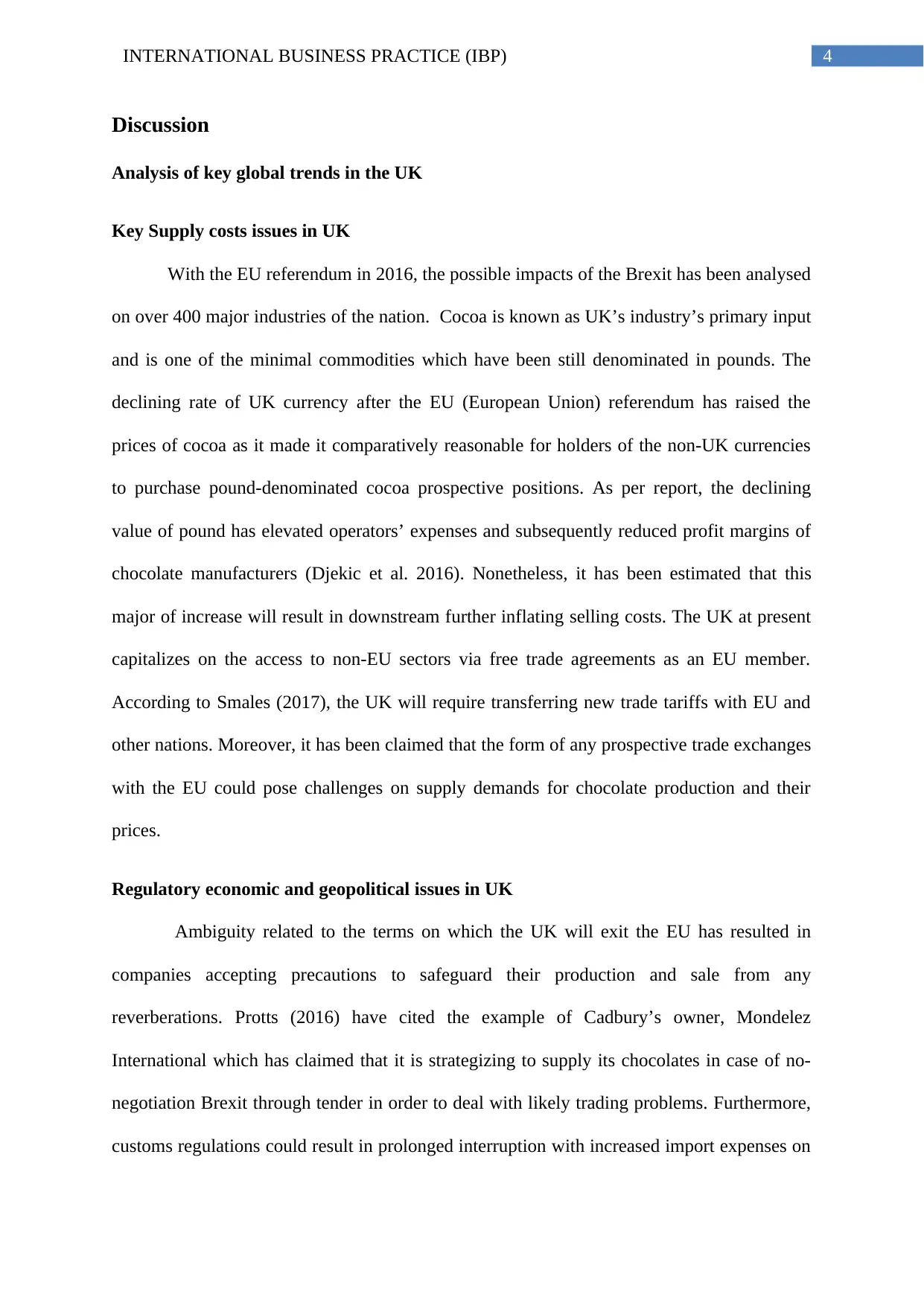
4INTERNATIONAL BUSINESS PRACTICE (IBP)
Discussion
Analysis of key global trends in the UK
Key Supply costs issues in UK
With the EU referendum in 2016, the possible impacts of the Brexit has been analysed
on over 400 major industries of the nation. Cocoa is known as UK’s industry’s primary input
and is one of the minimal commodities which have been still denominated in pounds. The
declining rate of UK currency after the EU (European Union) referendum has raised the
prices of cocoa as it made it comparatively reasonable for holders of the non-UK currencies
to purchase pound-denominated cocoa prospective positions. As per report, the declining
value of pound has elevated operators’ expenses and subsequently reduced profit margins of
chocolate manufacturers (Djekic et al. 2016). Nonetheless, it has been estimated that this
major of increase will result in downstream further inflating selling costs. The UK at present
capitalizes on the access to non-EU sectors via free trade agreements as an EU member.
According to Smales (2017), the UK will require transferring new trade tariffs with EU and
other nations. Moreover, it has been claimed that the form of any prospective trade exchanges
with the EU could pose challenges on supply demands for chocolate production and their
prices.
Regulatory economic and geopolitical issues in UK
Ambiguity related to the terms on which the UK will exit the EU has resulted in
companies accepting precautions to safeguard their production and sale from any
reverberations. Protts (2016) have cited the example of Cadbury’s owner, Mondelez
International which has claimed that it is strategizing to supply its chocolates in case of no-
negotiation Brexit through tender in order to deal with likely trading problems. Furthermore,
customs regulations could result in prolonged interruption with increased import expenses on
Discussion
Analysis of key global trends in the UK
Key Supply costs issues in UK
With the EU referendum in 2016, the possible impacts of the Brexit has been analysed
on over 400 major industries of the nation. Cocoa is known as UK’s industry’s primary input
and is one of the minimal commodities which have been still denominated in pounds. The
declining rate of UK currency after the EU (European Union) referendum has raised the
prices of cocoa as it made it comparatively reasonable for holders of the non-UK currencies
to purchase pound-denominated cocoa prospective positions. As per report, the declining
value of pound has elevated operators’ expenses and subsequently reduced profit margins of
chocolate manufacturers (Djekic et al. 2016). Nonetheless, it has been estimated that this
major of increase will result in downstream further inflating selling costs. The UK at present
capitalizes on the access to non-EU sectors via free trade agreements as an EU member.
According to Smales (2017), the UK will require transferring new trade tariffs with EU and
other nations. Moreover, it has been claimed that the form of any prospective trade exchanges
with the EU could pose challenges on supply demands for chocolate production and their
prices.
Regulatory economic and geopolitical issues in UK
Ambiguity related to the terms on which the UK will exit the EU has resulted in
companies accepting precautions to safeguard their production and sale from any
reverberations. Protts (2016) have cited the example of Cadbury’s owner, Mondelez
International which has claimed that it is strategizing to supply its chocolates in case of no-
negotiation Brexit through tender in order to deal with likely trading problems. Furthermore,
customs regulations could result in prolonged interruption with increased import expenses on
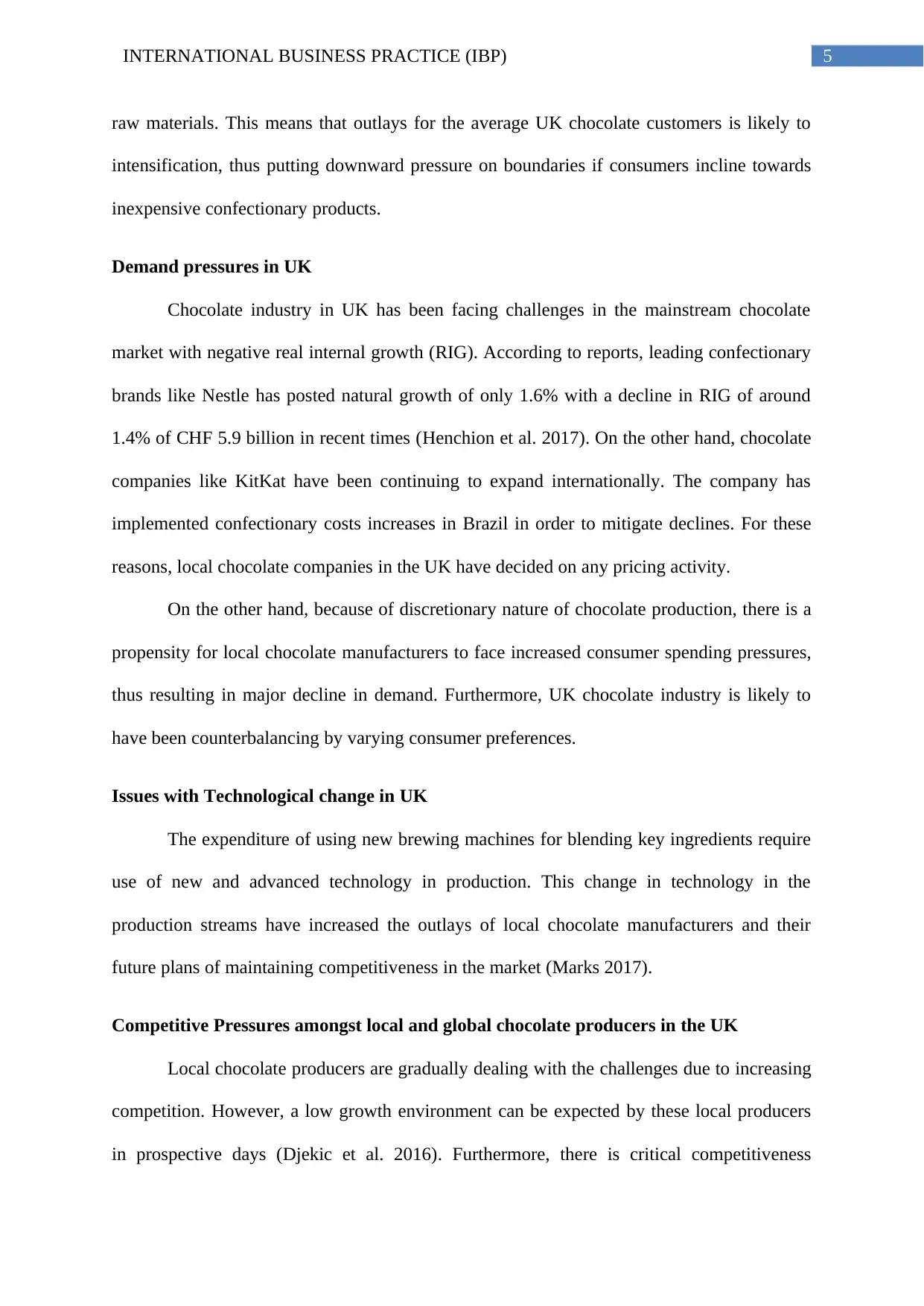
5INTERNATIONAL BUSINESS PRACTICE (IBP)
raw materials. This means that outlays for the average UK chocolate customers is likely to
intensification, thus putting downward pressure on boundaries if consumers incline towards
inexpensive confectionary products.
Demand pressures in UK
Chocolate industry in UK has been facing challenges in the mainstream chocolate
market with negative real internal growth (RIG). According to reports, leading confectionary
brands like Nestle has posted natural growth of only 1.6% with a decline in RIG of around
1.4% of CHF 5.9 billion in recent times (Henchion et al. 2017). On the other hand, chocolate
companies like KitKat have been continuing to expand internationally. The company has
implemented confectionary costs increases in Brazil in order to mitigate declines. For these
reasons, local chocolate companies in the UK have decided on any pricing activity.
On the other hand, because of discretionary nature of chocolate production, there is a
propensity for local chocolate manufacturers to face increased consumer spending pressures,
thus resulting in major decline in demand. Furthermore, UK chocolate industry is likely to
have been counterbalancing by varying consumer preferences.
Issues with Technological change in UK
The expenditure of using new brewing machines for blending key ingredients require
use of new and advanced technology in production. This change in technology in the
production streams have increased the outlays of local chocolate manufacturers and their
future plans of maintaining competitiveness in the market (Marks 2017).
Competitive Pressures amongst local and global chocolate producers in the UK
Local chocolate producers are gradually dealing with the challenges due to increasing
competition. However, a low growth environment can be expected by these local producers
in prospective days (Djekic et al. 2016). Furthermore, there is critical competitiveness
raw materials. This means that outlays for the average UK chocolate customers is likely to
intensification, thus putting downward pressure on boundaries if consumers incline towards
inexpensive confectionary products.
Demand pressures in UK
Chocolate industry in UK has been facing challenges in the mainstream chocolate
market with negative real internal growth (RIG). According to reports, leading confectionary
brands like Nestle has posted natural growth of only 1.6% with a decline in RIG of around
1.4% of CHF 5.9 billion in recent times (Henchion et al. 2017). On the other hand, chocolate
companies like KitKat have been continuing to expand internationally. The company has
implemented confectionary costs increases in Brazil in order to mitigate declines. For these
reasons, local chocolate companies in the UK have decided on any pricing activity.
On the other hand, because of discretionary nature of chocolate production, there is a
propensity for local chocolate manufacturers to face increased consumer spending pressures,
thus resulting in major decline in demand. Furthermore, UK chocolate industry is likely to
have been counterbalancing by varying consumer preferences.
Issues with Technological change in UK
The expenditure of using new brewing machines for blending key ingredients require
use of new and advanced technology in production. This change in technology in the
production streams have increased the outlays of local chocolate manufacturers and their
future plans of maintaining competitiveness in the market (Marks 2017).
Competitive Pressures amongst local and global chocolate producers in the UK
Local chocolate producers are gradually dealing with the challenges due to increasing
competition. However, a low growth environment can be expected by these local producers
in prospective days (Djekic et al. 2016). Furthermore, there is critical competitiveness
⊘ This is a preview!⊘
Do you want full access?
Subscribe today to unlock all pages.

Trusted by 1+ million students worldwide
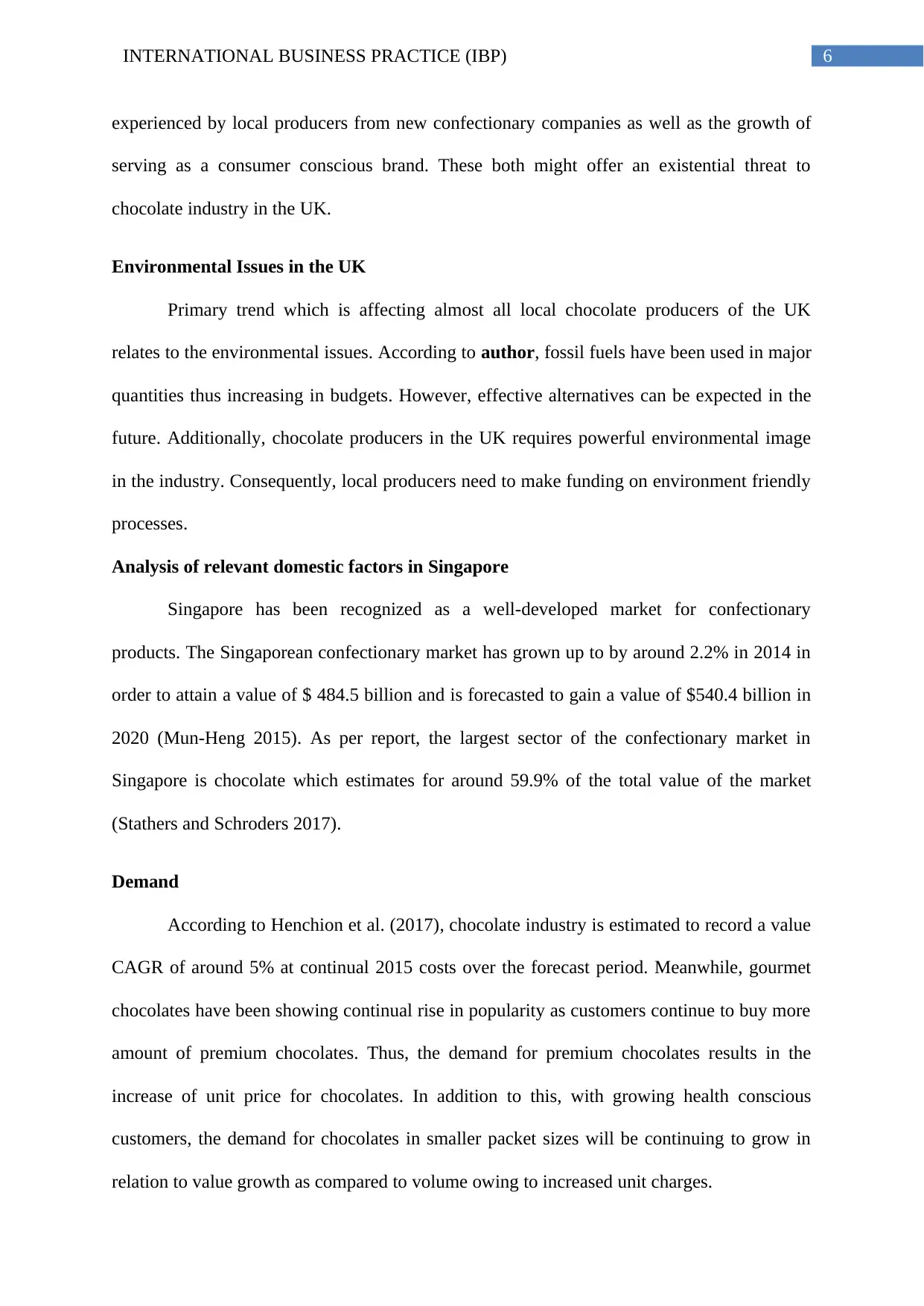
6INTERNATIONAL BUSINESS PRACTICE (IBP)
experienced by local producers from new confectionary companies as well as the growth of
serving as a consumer conscious brand. These both might offer an existential threat to
chocolate industry in the UK.
Environmental Issues in the UK
Primary trend which is affecting almost all local chocolate producers of the UK
relates to the environmental issues. According to author, fossil fuels have been used in major
quantities thus increasing in budgets. However, effective alternatives can be expected in the
future. Additionally, chocolate producers in the UK requires powerful environmental image
in the industry. Consequently, local producers need to make funding on environment friendly
processes.
Analysis of relevant domestic factors in Singapore
Singapore has been recognized as a well-developed market for confectionary
products. The Singaporean confectionary market has grown up to by around 2.2% in 2014 in
order to attain a value of $ 484.5 billion and is forecasted to gain a value of $540.4 billion in
2020 (Mun-Heng 2015). As per report, the largest sector of the confectionary market in
Singapore is chocolate which estimates for around 59.9% of the total value of the market
(Stathers and Schroders 2017).
Demand
According to Henchion et al. (2017), chocolate industry is estimated to record a value
CAGR of around 5% at continual 2015 costs over the forecast period. Meanwhile, gourmet
chocolates have been showing continual rise in popularity as customers continue to buy more
amount of premium chocolates. Thus, the demand for premium chocolates results in the
increase of unit price for chocolates. In addition to this, with growing health conscious
customers, the demand for chocolates in smaller packet sizes will be continuing to grow in
relation to value growth as compared to volume owing to increased unit charges.
experienced by local producers from new confectionary companies as well as the growth of
serving as a consumer conscious brand. These both might offer an existential threat to
chocolate industry in the UK.
Environmental Issues in the UK
Primary trend which is affecting almost all local chocolate producers of the UK
relates to the environmental issues. According to author, fossil fuels have been used in major
quantities thus increasing in budgets. However, effective alternatives can be expected in the
future. Additionally, chocolate producers in the UK requires powerful environmental image
in the industry. Consequently, local producers need to make funding on environment friendly
processes.
Analysis of relevant domestic factors in Singapore
Singapore has been recognized as a well-developed market for confectionary
products. The Singaporean confectionary market has grown up to by around 2.2% in 2014 in
order to attain a value of $ 484.5 billion and is forecasted to gain a value of $540.4 billion in
2020 (Mun-Heng 2015). As per report, the largest sector of the confectionary market in
Singapore is chocolate which estimates for around 59.9% of the total value of the market
(Stathers and Schroders 2017).
Demand
According to Henchion et al. (2017), chocolate industry is estimated to record a value
CAGR of around 5% at continual 2015 costs over the forecast period. Meanwhile, gourmet
chocolates have been showing continual rise in popularity as customers continue to buy more
amount of premium chocolates. Thus, the demand for premium chocolates results in the
increase of unit price for chocolates. In addition to this, with growing health conscious
customers, the demand for chocolates in smaller packet sizes will be continuing to grow in
relation to value growth as compared to volume owing to increased unit charges.
Paraphrase This Document
Need a fresh take? Get an instant paraphrase of this document with our AI Paraphraser
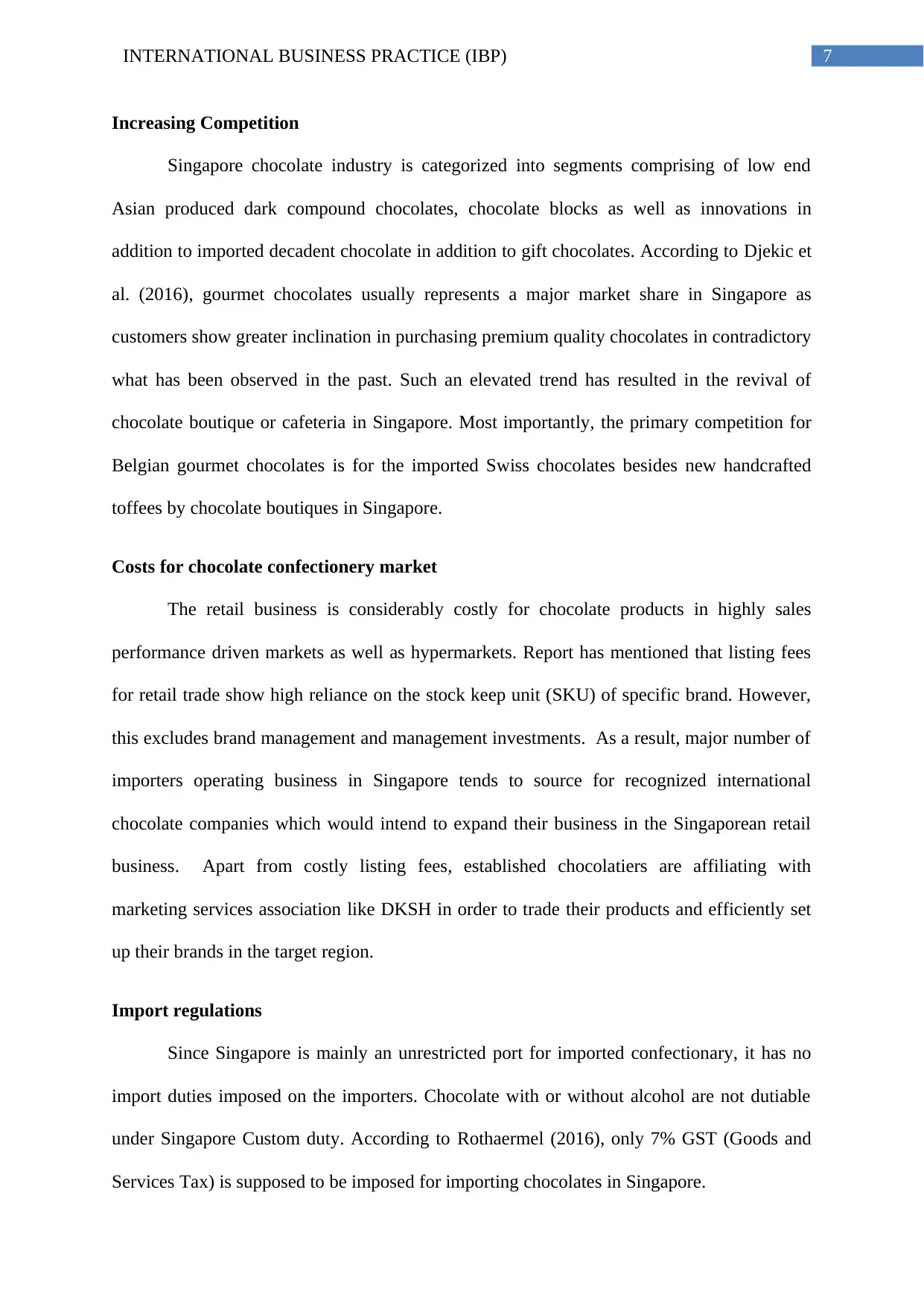
7INTERNATIONAL BUSINESS PRACTICE (IBP)
Increasing Competition
Singapore chocolate industry is categorized into segments comprising of low end
Asian produced dark compound chocolates, chocolate blocks as well as innovations in
addition to imported decadent chocolate in addition to gift chocolates. According to Djekic et
al. (2016), gourmet chocolates usually represents a major market share in Singapore as
customers show greater inclination in purchasing premium quality chocolates in contradictory
what has been observed in the past. Such an elevated trend has resulted in the revival of
chocolate boutique or cafeteria in Singapore. Most importantly, the primary competition for
Belgian gourmet chocolates is for the imported Swiss chocolates besides new handcrafted
toffees by chocolate boutiques in Singapore.
Costs for chocolate confectionery market
The retail business is considerably costly for chocolate products in highly sales
performance driven markets as well as hypermarkets. Report has mentioned that listing fees
for retail trade show high reliance on the stock keep unit (SKU) of specific brand. However,
this excludes brand management and management investments. As a result, major number of
importers operating business in Singapore tends to source for recognized international
chocolate companies which would intend to expand their business in the Singaporean retail
business. Apart from costly listing fees, established chocolatiers are affiliating with
marketing services association like DKSH in order to trade their products and efficiently set
up their brands in the target region.
Import regulations
Since Singapore is mainly an unrestricted port for imported confectionary, it has no
import duties imposed on the importers. Chocolate with or without alcohol are not dutiable
under Singapore Custom duty. According to Rothaermel (2016), only 7% GST (Goods and
Services Tax) is supposed to be imposed for importing chocolates in Singapore.
Increasing Competition
Singapore chocolate industry is categorized into segments comprising of low end
Asian produced dark compound chocolates, chocolate blocks as well as innovations in
addition to imported decadent chocolate in addition to gift chocolates. According to Djekic et
al. (2016), gourmet chocolates usually represents a major market share in Singapore as
customers show greater inclination in purchasing premium quality chocolates in contradictory
what has been observed in the past. Such an elevated trend has resulted in the revival of
chocolate boutique or cafeteria in Singapore. Most importantly, the primary competition for
Belgian gourmet chocolates is for the imported Swiss chocolates besides new handcrafted
toffees by chocolate boutiques in Singapore.
Costs for chocolate confectionery market
The retail business is considerably costly for chocolate products in highly sales
performance driven markets as well as hypermarkets. Report has mentioned that listing fees
for retail trade show high reliance on the stock keep unit (SKU) of specific brand. However,
this excludes brand management and management investments. As a result, major number of
importers operating business in Singapore tends to source for recognized international
chocolate companies which would intend to expand their business in the Singaporean retail
business. Apart from costly listing fees, established chocolatiers are affiliating with
marketing services association like DKSH in order to trade their products and efficiently set
up their brands in the target region.
Import regulations
Since Singapore is mainly an unrestricted port for imported confectionary, it has no
import duties imposed on the importers. Chocolate with or without alcohol are not dutiable
under Singapore Custom duty. According to Rothaermel (2016), only 7% GST (Goods and
Services Tax) is supposed to be imposed for importing chocolates in Singapore.
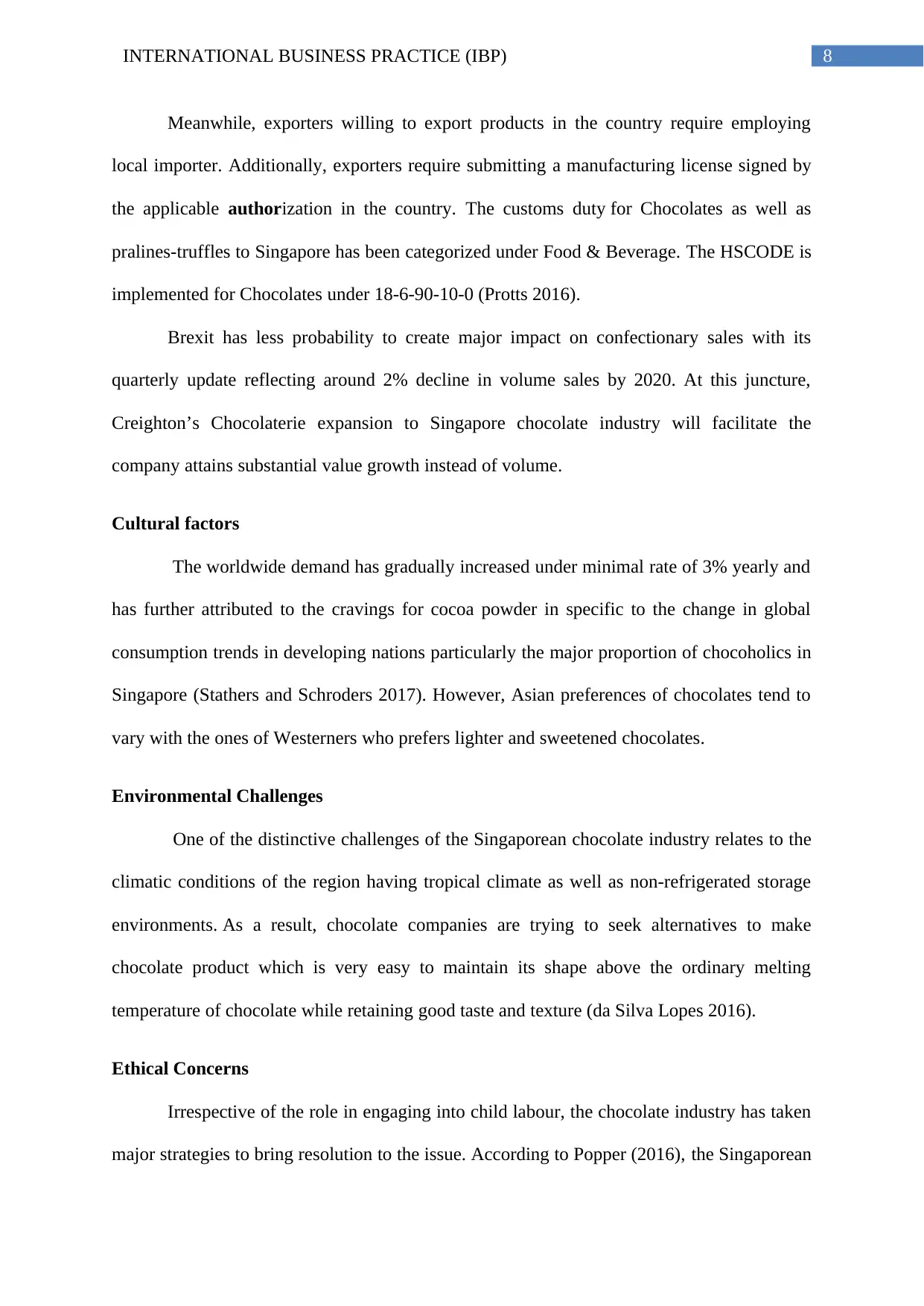
8INTERNATIONAL BUSINESS PRACTICE (IBP)
Meanwhile, exporters willing to export products in the country require employing
local importer. Additionally, exporters require submitting a manufacturing license signed by
the applicable authorization in the country. The customs duty for Chocolates as well as
pralines-truffles to Singapore has been categorized under Food & Beverage. The HSCODE is
implemented for Chocolates under 18-6-90-10-0 (Protts 2016).
Brexit has less probability to create major impact on confectionary sales with its
quarterly update reflecting around 2% decline in volume sales by 2020. At this juncture,
Creighton’s Chocolaterie expansion to Singapore chocolate industry will facilitate the
company attains substantial value growth instead of volume.
Cultural factors
The worldwide demand has gradually increased under minimal rate of 3% yearly and
has further attributed to the cravings for cocoa powder in specific to the change in global
consumption trends in developing nations particularly the major proportion of chocoholics in
Singapore (Stathers and Schroders 2017). However, Asian preferences of chocolates tend to
vary with the ones of Westerners who prefers lighter and sweetened chocolates.
Environmental Challenges
One of the distinctive challenges of the Singaporean chocolate industry relates to the
climatic conditions of the region having tropical climate as well as non-refrigerated storage
environments. As a result, chocolate companies are trying to seek alternatives to make
chocolate product which is very easy to maintain its shape above the ordinary melting
temperature of chocolate while retaining good taste and texture (da Silva Lopes 2016).
Ethical Concerns
Irrespective of the role in engaging into child labour, the chocolate industry has taken
major strategies to bring resolution to the issue. According to Popper (2016), the Singaporean
Meanwhile, exporters willing to export products in the country require employing
local importer. Additionally, exporters require submitting a manufacturing license signed by
the applicable authorization in the country. The customs duty for Chocolates as well as
pralines-truffles to Singapore has been categorized under Food & Beverage. The HSCODE is
implemented for Chocolates under 18-6-90-10-0 (Protts 2016).
Brexit has less probability to create major impact on confectionary sales with its
quarterly update reflecting around 2% decline in volume sales by 2020. At this juncture,
Creighton’s Chocolaterie expansion to Singapore chocolate industry will facilitate the
company attains substantial value growth instead of volume.
Cultural factors
The worldwide demand has gradually increased under minimal rate of 3% yearly and
has further attributed to the cravings for cocoa powder in specific to the change in global
consumption trends in developing nations particularly the major proportion of chocoholics in
Singapore (Stathers and Schroders 2017). However, Asian preferences of chocolates tend to
vary with the ones of Westerners who prefers lighter and sweetened chocolates.
Environmental Challenges
One of the distinctive challenges of the Singaporean chocolate industry relates to the
climatic conditions of the region having tropical climate as well as non-refrigerated storage
environments. As a result, chocolate companies are trying to seek alternatives to make
chocolate product which is very easy to maintain its shape above the ordinary melting
temperature of chocolate while retaining good taste and texture (da Silva Lopes 2016).
Ethical Concerns
Irrespective of the role in engaging into child labour, the chocolate industry has taken
major strategies to bring resolution to the issue. According to Popper (2016), the Singaporean
⊘ This is a preview!⊘
Do you want full access?
Subscribe today to unlock all pages.

Trusted by 1+ million students worldwide
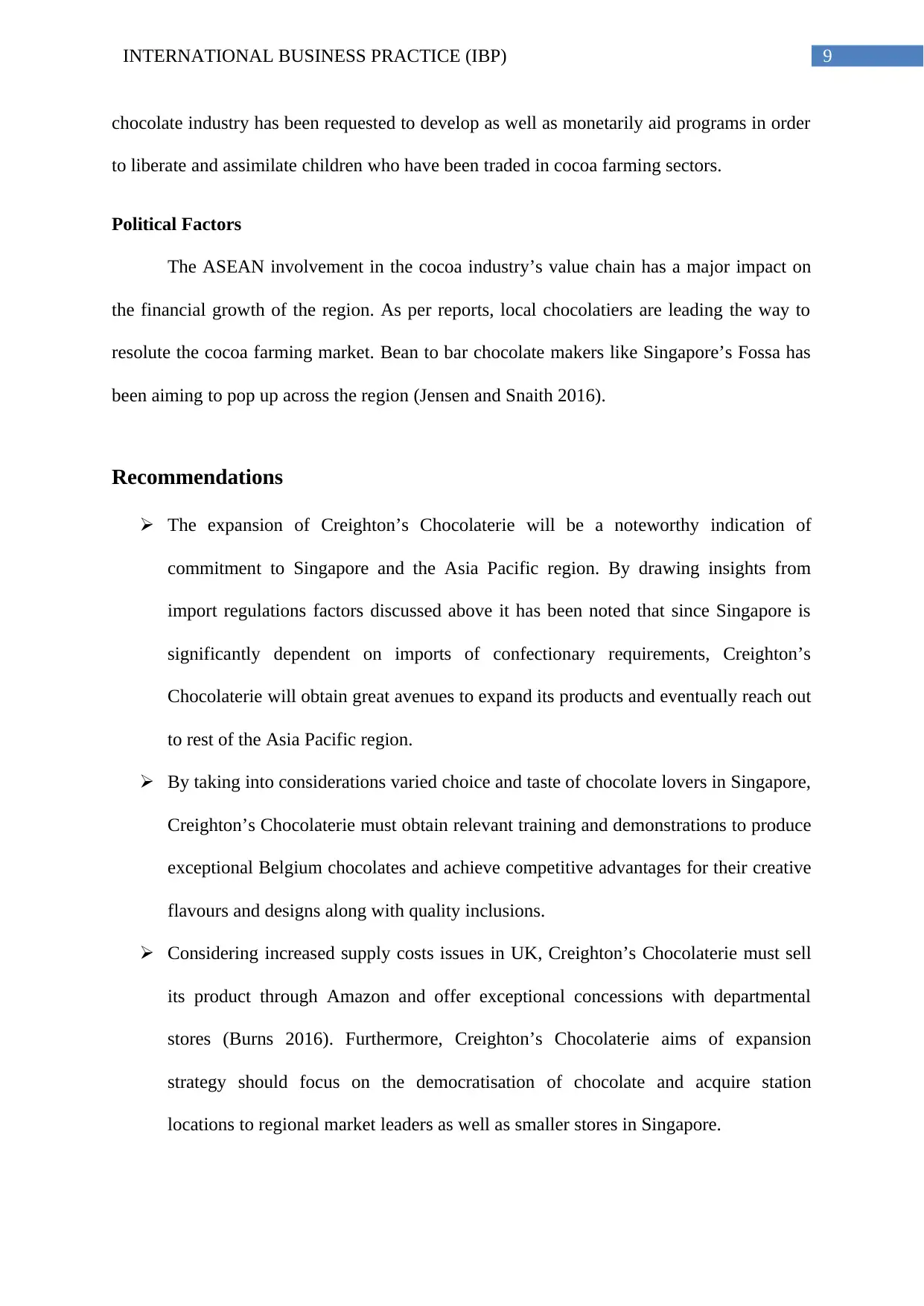
9INTERNATIONAL BUSINESS PRACTICE (IBP)
chocolate industry has been requested to develop as well as monetarily aid programs in order
to liberate and assimilate children who have been traded in cocoa farming sectors.
Political Factors
The ASEAN involvement in the cocoa industry’s value chain has a major impact on
the financial growth of the region. As per reports, local chocolatiers are leading the way to
resolute the cocoa farming market. Bean to bar chocolate makers like Singapore’s Fossa has
been aiming to pop up across the region (Jensen and Snaith 2016).
Recommendations
The expansion of Creighton’s Chocolaterie will be a noteworthy indication of
commitment to Singapore and the Asia Pacific region. By drawing insights from
import regulations factors discussed above it has been noted that since Singapore is
significantly dependent on imports of confectionary requirements, Creighton’s
Chocolaterie will obtain great avenues to expand its products and eventually reach out
to rest of the Asia Pacific region.
By taking into considerations varied choice and taste of chocolate lovers in Singapore,
Creighton’s Chocolaterie must obtain relevant training and demonstrations to produce
exceptional Belgium chocolates and achieve competitive advantages for their creative
flavours and designs along with quality inclusions.
Considering increased supply costs issues in UK, Creighton’s Chocolaterie must sell
its product through Amazon and offer exceptional concessions with departmental
stores (Burns 2016). Furthermore, Creighton’s Chocolaterie aims of expansion
strategy should focus on the democratisation of chocolate and acquire station
locations to regional market leaders as well as smaller stores in Singapore.
chocolate industry has been requested to develop as well as monetarily aid programs in order
to liberate and assimilate children who have been traded in cocoa farming sectors.
Political Factors
The ASEAN involvement in the cocoa industry’s value chain has a major impact on
the financial growth of the region. As per reports, local chocolatiers are leading the way to
resolute the cocoa farming market. Bean to bar chocolate makers like Singapore’s Fossa has
been aiming to pop up across the region (Jensen and Snaith 2016).
Recommendations
The expansion of Creighton’s Chocolaterie will be a noteworthy indication of
commitment to Singapore and the Asia Pacific region. By drawing insights from
import regulations factors discussed above it has been noted that since Singapore is
significantly dependent on imports of confectionary requirements, Creighton’s
Chocolaterie will obtain great avenues to expand its products and eventually reach out
to rest of the Asia Pacific region.
By taking into considerations varied choice and taste of chocolate lovers in Singapore,
Creighton’s Chocolaterie must obtain relevant training and demonstrations to produce
exceptional Belgium chocolates and achieve competitive advantages for their creative
flavours and designs along with quality inclusions.
Considering increased supply costs issues in UK, Creighton’s Chocolaterie must sell
its product through Amazon and offer exceptional concessions with departmental
stores (Burns 2016). Furthermore, Creighton’s Chocolaterie aims of expansion
strategy should focus on the democratisation of chocolate and acquire station
locations to regional market leaders as well as smaller stores in Singapore.
Paraphrase This Document
Need a fresh take? Get an instant paraphrase of this document with our AI Paraphraser
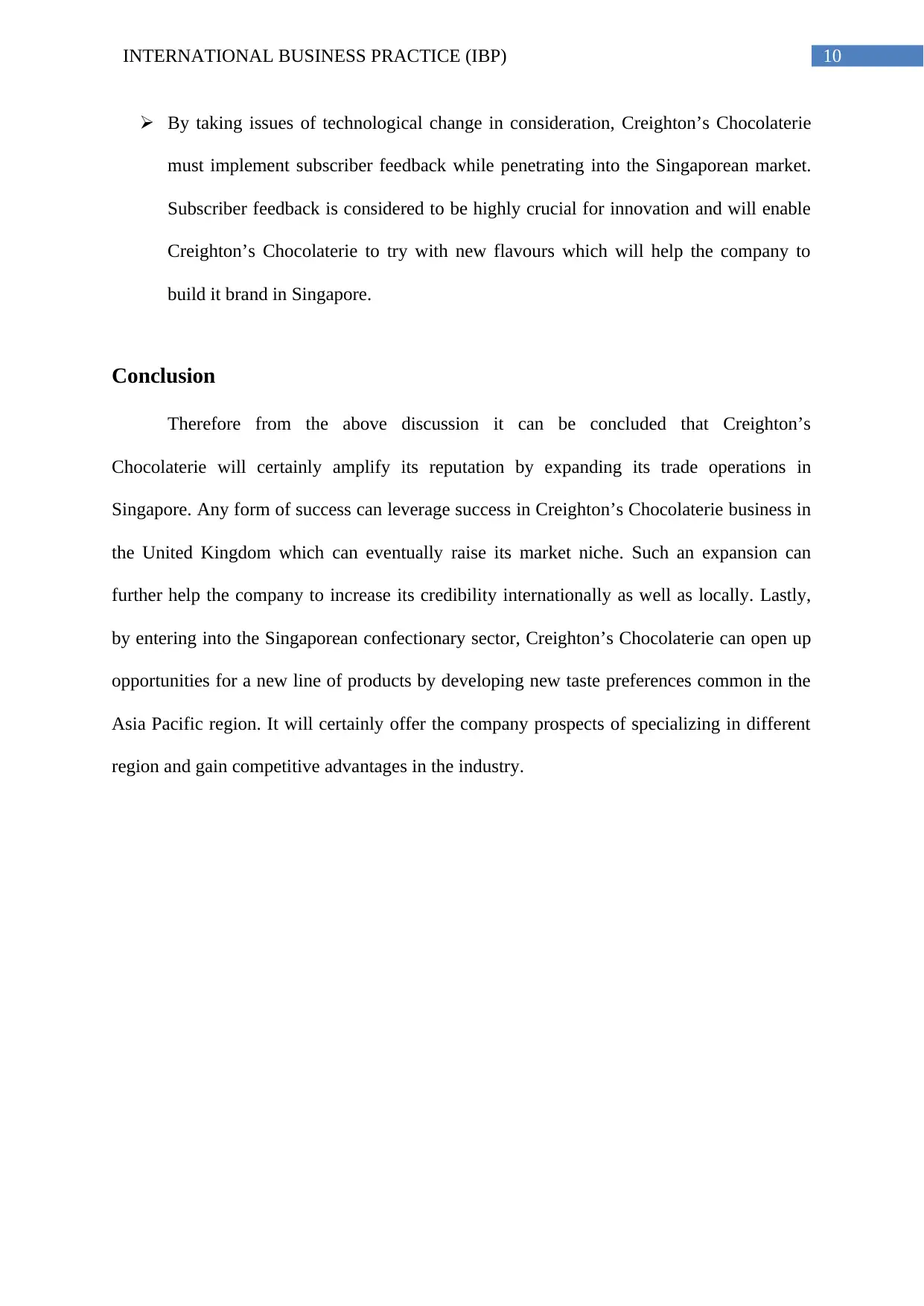
10INTERNATIONAL BUSINESS PRACTICE (IBP)
By taking issues of technological change in consideration, Creighton’s Chocolaterie
must implement subscriber feedback while penetrating into the Singaporean market.
Subscriber feedback is considered to be highly crucial for innovation and will enable
Creighton’s Chocolaterie to try with new flavours which will help the company to
build it brand in Singapore.
Conclusion
Therefore from the above discussion it can be concluded that Creighton’s
Chocolaterie will certainly amplify its reputation by expanding its trade operations in
Singapore. Any form of success can leverage success in Creighton’s Chocolaterie business in
the United Kingdom which can eventually raise its market niche. Such an expansion can
further help the company to increase its credibility internationally as well as locally. Lastly,
by entering into the Singaporean confectionary sector, Creighton’s Chocolaterie can open up
opportunities for a new line of products by developing new taste preferences common in the
Asia Pacific region. It will certainly offer the company prospects of specializing in different
region and gain competitive advantages in the industry.
By taking issues of technological change in consideration, Creighton’s Chocolaterie
must implement subscriber feedback while penetrating into the Singaporean market.
Subscriber feedback is considered to be highly crucial for innovation and will enable
Creighton’s Chocolaterie to try with new flavours which will help the company to
build it brand in Singapore.
Conclusion
Therefore from the above discussion it can be concluded that Creighton’s
Chocolaterie will certainly amplify its reputation by expanding its trade operations in
Singapore. Any form of success can leverage success in Creighton’s Chocolaterie business in
the United Kingdom which can eventually raise its market niche. Such an expansion can
further help the company to increase its credibility internationally as well as locally. Lastly,
by entering into the Singaporean confectionary sector, Creighton’s Chocolaterie can open up
opportunities for a new line of products by developing new taste preferences common in the
Asia Pacific region. It will certainly offer the company prospects of specializing in different
region and gain competitive advantages in the industry.

11INTERNATIONAL BUSINESS PRACTICE (IBP)
References
Burns, P., 2016. Entrepreneurship and small business. Palgrave Macmillan Limited.
Creighton's Chocolaterie., 2020. About — Creighton's Chocolaterie. Retrieved 6 February
2020, from https://www.creightonschocolaterie.com/about-1
da Silva Lopes, T., 2016. Building brand reputation through third-party endorsement: Fair
trade in British chocolate. Business History Review, 90(3), pp.457-482.
De Mooij, M., 2018. Global marketing and advertising: Understanding cultural paradoxes.
SAGE Publications Limited.
Djekic, I., Dragojlovic, S., Miloradovic, Z., Miljkovic-Zivanovic, S., Savic, M. and Kekic,
V., 2016. Improving the confectionery industry supply chain through second party
audits. British Food Journal, 118(5), pp.1041-1066.
Henchion, M., Hayes, M., Mullen, A.M., Fenelon, M. and Tiwari, B., 2017. Future protein
supply and demand: strategies and factors influencing a sustainable equilibrium. Foods, 6(7),
p.53.
Jensen, M.D. and Snaith, H., 2016. When politics prevails: the political economy of a
Brexit. Journal of European Public Policy, 23(9), pp.1302-1310.
Marks, S.V., 2017. Non-tariff trade regulations in Indonesia: Nominal and effective rates of
protection. Bulletin of Indonesian Economic Studies, 53(3), pp.333-357.
Morschett, D., Schramm-Klein, H. and Zentes, J., 2015. Strategic international
management (pp. 978-3658078836). Springer.
References
Burns, P., 2016. Entrepreneurship and small business. Palgrave Macmillan Limited.
Creighton's Chocolaterie., 2020. About — Creighton's Chocolaterie. Retrieved 6 February
2020, from https://www.creightonschocolaterie.com/about-1
da Silva Lopes, T., 2016. Building brand reputation through third-party endorsement: Fair
trade in British chocolate. Business History Review, 90(3), pp.457-482.
De Mooij, M., 2018. Global marketing and advertising: Understanding cultural paradoxes.
SAGE Publications Limited.
Djekic, I., Dragojlovic, S., Miloradovic, Z., Miljkovic-Zivanovic, S., Savic, M. and Kekic,
V., 2016. Improving the confectionery industry supply chain through second party
audits. British Food Journal, 118(5), pp.1041-1066.
Henchion, M., Hayes, M., Mullen, A.M., Fenelon, M. and Tiwari, B., 2017. Future protein
supply and demand: strategies and factors influencing a sustainable equilibrium. Foods, 6(7),
p.53.
Jensen, M.D. and Snaith, H., 2016. When politics prevails: the political economy of a
Brexit. Journal of European Public Policy, 23(9), pp.1302-1310.
Marks, S.V., 2017. Non-tariff trade regulations in Indonesia: Nominal and effective rates of
protection. Bulletin of Indonesian Economic Studies, 53(3), pp.333-357.
Morschett, D., Schramm-Klein, H. and Zentes, J., 2015. Strategic international
management (pp. 978-3658078836). Springer.
⊘ This is a preview!⊘
Do you want full access?
Subscribe today to unlock all pages.

Trusted by 1+ million students worldwide
1 out of 15
Related Documents
Your All-in-One AI-Powered Toolkit for Academic Success.
+13062052269
info@desklib.com
Available 24*7 on WhatsApp / Email
![[object Object]](/_next/static/media/star-bottom.7253800d.svg)
Unlock your academic potential
Copyright © 2020–2025 A2Z Services. All Rights Reserved. Developed and managed by ZUCOL.





